Papers by Dr. Kofi Agyekum

Dampness is a subject area plagued with misunderstandings over terminology and thinking. Rising d... more Dampness is a subject area plagued with misunderstandings over terminology and thinking. Rising damp, a type of dampness, is one of the most severe phenomena that leads to decay and deterioration of both old and modern types of buildings. This study sought to diagnose the problem of rising damp in the walls of three residential buildings using a four-stage approach to damp investigation (i.e. visual inspection, non-destructive testing, destructive testing and laboratory assessment study). The stage 1 approach (visual inspection) showed that blistering of paints, flaking of mortar, surface efflorescence, among others were the key symptoms of rising dampness identified with the three buildings. The stage 2 approach (non-destructive testing) showed that the walls of all the buildings were affected by dampness. The stages 3 and 4 approaches (destructive testing and laboratory assessment studies) revealed that the mortar samples obtained from the three buildings were affected by different salt groups. The study concludes by revealing that although all the salts identified in the current study can be damaging, sodium sulphate (Na2SO4), magnesium sulphate (MgSO4) and magnesium chloride (MgCl2) are more damaging and can result in more extensive decay in the walls of the three buildings than all the othersalt types identified. An understanding of these results is very important because knowing the types of salts present in an affected building will lead to the adoption of appropriate treatment methods to control the problem.

Engineering, Construction and Architectural Management, 2021
PurposeThough the Public Procurement Act of Ghana makes room for specific socio-economic policies... more PurposeThough the Public Procurement Act of Ghana makes room for specific socio-economic policies (environmental, social, economic and other policies which are intended to promote social and economic impact), there is no explicit definition and provision for social value as an evaluation criterion, culminating in the absence of a definition in the Act. This paper elicits the conception and understanding of social value from stakeholders in the Ghanaian construction industry.Design/methodology/approachThe study adopted a qualitative method that relied on a semi-structured interview of 30 participants purposively drawn from Western, Western North and Central regions of Ghana. An inductive thematic analysis approach, which involved identifying repetitions, exploring similarities and differences, noting linguistic connectors, and a framework were employed to analyse the data.FindingsThe study established no single definition or explanation for social value in the construction industry i...

Built Environment Project and Asset Management, 2021
PurposeThis study examines occupants' satisfaction with the indoor environmental quality (IEQ... more PurposeThis study examines occupants' satisfaction with the indoor environmental quality (IEQ) of a green-certified building [The Green Star South Africa (SA) Building] in Ghana.Design/methodology/approachViews of 300 respondents are solicited on 15 IEQ (obtained through a critical review of the literature and complemented with a pilot interview on the subject) parameters. Data obtained are analysed using both descriptive and inferential statistics.FindingsFindings suggest that occupants are generally satisfied with five critical aspects of IEQ. The results also indicate that the occupants perceive five key IEQ parameters to have high levels of importance. Further inferential analysis of the parameters revealed that two core IEQs require the highest levels of improvement actions.Research limitations/implicationsThe study was conducted in Ghana and analysed occupants' perceptions of working within one green-certified building. Again, the collection of the occupants' respo...
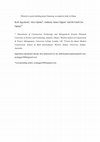
International Journal of Construction Management, 2020
This study examines the perception of professionals in the Ghanaian construction industry regardi... more This study examines the perception of professionals in the Ghanaian construction industry regarding the obstacles to green building project financing. Following an extensive critical comparative review of literature resulting in the identification of ten potential obstacles, a cross-sectional survey was conducted among 520 construction industry professionals. Data obtained from the survey were analysed using both descriptive and inferential statistics. The findings from the study revealed that split incentives, risk related barriers, capital expenditure, lack of incentives, and initial capital cost are the key obstacles that hinder green building project financing. The findings further revealed significant differences in the views of the professionals regarding four obstacles to green building project financing. From the discussion, it was realised that for some of the identified obstacles, the differences resulted from the fact that the different professionals have different interests in green building projects, and those interests depict the kind of risks they are exposed to. The value of this paper is to help built environment professionals to understand these obstacles and find a better way of turning these challenges into opportunities for the construction industry.

International Journal of Productivity and Performance Management, 2020
PurposeReligiousness is evident in every aspect of life, and its impact on construction project p... more PurposeReligiousness is evident in every aspect of life, and its impact on construction project performance is undeniable. However, little has been done to fully understand the influences one's religiosity has on performance factors. This paper aims to explore the influence of religious elements on performance factors in the Ghanaian construction industry (GCI).Design/methodology/approachUsing a desk survey and closed-ended questionnaire, data were obtained from the three religious' bodies (Christianity, Islamic and Traditionalist) in Ghana. The analysis of the collected data was done using mean score ranking and regression analysis.FindingsIt was revealed that most of the religious bodies were aware of the presence of the seven factors identified for measuring construction project performance. The findings suggested that there was a significant and positive relationship between the religious elements (of all the three religions) and cost as well as schedule performance. Isl...

Smart and Sustainable Built Environment, 2020
PurposeSustainability has become a topical issue in many countries, with emphasis on green buildi... more PurposeSustainability has become a topical issue in many countries, with emphasis on green buildings. Though Ghana has recently adopted green buildings, there is lack of its speedy implementation. There is little literature on the adoption of green certification of buildings, especially in a developing country like Ghana. The purpose of this paper is to identify the factors that drive the adoption of green certification of buildings in Ghana.Design/methodology/approachThe study adopts face-to-face and telephone interviews, using a semi-structured interview guide among ten built environment professionals. Qualitative responses to the interview are thematically analysed using Nvivo 11 Pro analysis application software.FindingsThe findings suggest that “observability of the benefits of green certified buildings”, “commitment of Government to green building initiatives”, “incorporating green certification of buildings into the code of practice of professional bodies”, “green building ce...

Journal of Engineering, Design and Technology, 2020
Purpose This paper aims to examine the factors that drive the career progression of construction ... more Purpose This paper aims to examine the factors that drive the career progression of construction project managers (CPM) in the Ghanaian construction industry. Design/methodology/approach Based on the quantitative approach, the views of 80 CPMs working with D1 building construction firms were elicited using a structured questionnaire. Data was analysed using one-sample t-test, which was used to examine the relative significance of the variables. The mean scores, standard deviations and significance values (p-values) of each variable were used to examine the outcome of the survey. Findings The findings suggest that “existence of organizational support systems”, “ability to create identity”, “having an influential mentor and coach”, “accepting complicated and high visibility assignments” and “ability to gain managerial or leadership experience” are the key factors that drive the career progression of CPMs in Ghana. Research limitations/implications Findings from this study is limited t...

SSRN Electronic Journal, 2019
Since the mid 1980’s, Sustainable Development as a term has been made prominent and played a cent... more Since the mid 1980’s, Sustainable Development as a term has been made prominent and played a central role in discussions about environmental policies, academic studies and governmental initiatives. Overtime, Sustainable development has been seen to be primarily centered on society and its ability to integrate environmental consideration in driving societal change. While the concept of sustainable development (SD) generally refers to achieving a balance among the environmental, economic, and social pillars of sustainability, the meaning and associated objectives of the social pillar remain vague. Indeed, it has been described as the most conceptually elusive pillar in SD discourse. This paper forms a part of efforts to define contextually the principles of social sustainability as seen in the Ghanaian construction industry. It assesses the knowledge level of design professionals (Architects) on the principles of social sustainability. This study was carried out using 85 practicing Architects from all over the country and attempts to identify the degree to which these professionals understand and can identify with the principles of Sustainability.
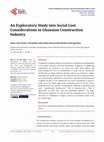
Journal of Building Construction and Planning Research, 2020
Construction causative nuisances, inconveniences, interferences and disruptions to the routine ec... more Construction causative nuisances, inconveniences, interferences and disruptions to the routine economic and social life patterns of adjacent or neighboring communities are referred to as social cost. This study explores the understanding and level of consideration of social cost by construction professionals in Ghana. Relevant literature sources are reviewed to define, rationalize and classify social cost. The study used the survey approach with a set of questionnaires addressed to construction contractors and professionals to gather the data. It was realized that not much consideration is given to social cost at the tender stage of the construction process. The five factors hindering social cost inclusion in tendering are "difficulty in allocating social costs", "governmental interferences", "lack of historical data", "lack of appreciation of social costs" and "low stakeholder agitation". The paper advocated for integration of social cost into the tendering process. The study will serve as a foundation to design a social cost assessment system at the pre-contract stage.
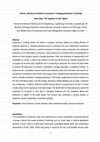
International Journal of Building Pathology and Adaptation, 2019
PurposeDampness in buildings affects the health of occupants, structural stability and energy eff... more PurposeDampness in buildings affects the health of occupants, structural stability and energy efficiency of buildings. Solutions to managing dampness focus on promoting the use of damp-proof construction materials, enhancing methods to avoid the introduction of moisture during construction and creating the awareness on the health effect of dampness. These solutions are incomplete without the identification of behaviours that occupants require to manage dampness. Given that dampness is characterised by the availability of a source, a route for the moisture to travel and driving force for moisture movement, the occupants can be said to play a significant role in contributing to dampness. The paper aims to discuss these issues.Design/methodology/approachAs a result, this study seeks to examine the behaviours of occupants manifested to manage dampness in residential buildings. To achieve the aim, a qualitative research method was employed, under which interviews were carried out. Occupa...
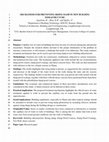
International Journal of Building Pathology and Adaptation, 2019
PurposeCapillary rise of water in buildings has been an issue of concern among past and present r... more PurposeCapillary rise of water in buildings has been an issue of concern among past and present researchers. Despite the research efforts devoted to the proper elimination of the problem in masonry construction, it still remains a challenge that needs to be addressed. The purpose of this paper is to explore treatment mechanisms that can be used to prevent rising damp in new building infrastructure.Design/methodology/approachIn total, 14 test walls are constructed, conditioned, subjected to various treatments and monitored for four years. The treatments applied to the walls include the use of polyethylene damp proof courses, damp proof coatings and dense concrete bases. The walls are then monitored with reference to the two climate seasons in Ghana.FindingsThe results highlight that rising damp is present, as suggested by the constant increase and decrease in the height of the water levels in the walls during the rainy and dry seasons, respectively. The findings further reveal that w...

International Journal of Procurement Management, 2019
This study examines the extent to which the Colleges of Education (COEs) in Ghana comply with one... more This study examines the extent to which the Colleges of Education (COEs) in Ghana comply with one of the key provisions; transparency in the Public Procurement Act 663 of Ghana. A questionnaire survey was conducted among 53 tender committee members in seven COEs in Ashanti Region, Ghana. Respondents were interviewed using tools for assessing transparency which were spelt out in five thematic areas. Data obtained was analysed through percentages, mean scores and relative importance indices. Findings show that the average percentage level of compliance with the transparency provisions in Act 663 among the COEs is 77.4%, indicating that the COEs complied with the transparency provisions in the Act 663. Findings from this study should encourage people in managerial positions in all sectors where procurement is carried out within Ghana to ensure that they comply with the transparency provisions in the act to help fight the menace of corruption.

Journal of Engineering, Design and Technology, 2019
Purpose This paper aims to identify the key barriers to the adoption of green certification of bu... more Purpose This paper aims to identify the key barriers to the adoption of green certification of buildings in Ghana. Design/methodology/approach The study adopts face-to-face and telephonic interviews with ten built environment professionals, using a semi-structured interview guide. Qualitative responses to the interview were thematically analysed using NVivo 11 Pro analysis application software. Findings The findings suggest that “lack of information on existing green buildings”, “lack of incentives”, “conservative nature of Ghanaians”, “lack of active government participation”, “inadequate human resource”, “lack of awareness of the benefits”, “cost and financing” and “lack of legal backing” are the eight key barriers that hinder the adoption of green certification of buildings. Research limitations/implications The research is limited to built environment professionals registered with their appropriate professional bodies. The findings cannot be generalized and extended to other dev...

Journal of Financial Management of Property and Construction, 2020
Purpose Supply chain (SC) disruption, whether demand sided or supply sided, is conversely perceiv... more Purpose Supply chain (SC) disruption, whether demand sided or supply sided, is conversely perceived to affect organisational performance of construction firms. This paper, therefore, aims to examine the linkage of supply chain disruptions with organisational performance of construction firms through the moderating role of innovation. Design/methodology/approach Using a quantitative research, approach the views of 84 construction professionals were elicited using a structured questionnaire. Ordinary least squares were utilised to validate the hypotheses set. Findings The study proved that there is a negative relationship between demand-related disruption and business performance as well as project performance. Also, it was clear from the study that supply-related disruptions had a significant impact on both project performance and business performance. Although SC innovation was seen to impact business performance, it had no relationship with project performance. Generally, innovatio...
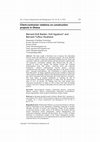
International Journal of Project Organisation and Management, 2018
This study sought to determine ways to improve the relationship between clients and contractors o... more This study sought to determine ways to improve the relationship between clients and contractors on construction projects. The study identifies 14 measures central to improving relationship building between clients and contractors within the construction industry and their prevalence explored from 145 contractors, conveniently sampled. Data obtained from the study is analysed by mean score ranking. The findings revealed that 'ensuring professionalism from both parties', 'achieving client and contractor satisfaction', 'effective communication between parties', 'ensuring commitment from both parties', 'attaching importance to the project by each party', 'ensuring trustworthiness', and 'conformance to contract agreements from both parties' are highly significant measures that contribute to improving client-contractor relationship. Neglect of the identified measures by either party may lead to frustration from the individual and overall objectives of projects. This study makes an original contribution of exploring the area of client-contractor relationship management in Ghana from the practitioners' point of view. In practice, the findings from this study should assist construction practitioners in Ghana as well as those from other developing countries who seek to manage relationships between clients and contractors on projects.
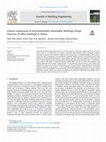
Journal of Building Engineering, 2019
Sustainable building design practices has in recent times become a topical issue among researcher... more Sustainable building design practices has in recent times become a topical issue among researchers and practitioners. However, in tropical built environment, particularly office buildings, there is inadequate empirical knowledge on practices that should be considered at the design stage of sustainable buildings. This study examines the critical components of environmentally sustainable building practices at the design stage for office buildings in the tropical built environment. Using quantitative research method five hypotheses were tested. The views of 250 professionals in the building industry were elicited using structured questionnaire. A confirmatory factor analysis (CFA) based on Structural Equation Model (SEM) was used to validate the hypotheses. The findings suggest that the five major components that is energy efficiency and conservation, water efficiency and conservation, material conservation, waste reduction, reuse and recycling and humane adaptation all positively influence sustainable design practices of office buildings in tropical regions, specifically Ghana. This finding suggests the critical components for environmentally sustainable building design practices for tropical regions which other tropical countries can emulate. The finding may be useful for professionals during design stage of projects to preserve the environment and its resources.

Built Environment Project and Asset Management, 2019
Purpose Monitoring and evaluation (M&E) of projects is a very important aspect of project executi... more Purpose Monitoring and evaluation (M&E) of projects is a very important aspect of project execution and management. This is because proper M&E practices have a significant effect on the successful delivery of projects. The purpose of this paper is to examine the impact of project M&E practices on construction project success criteria. Design/methodology/approach Structured questionnaires were used to solicit the views of project professionals in the Ghanaian construction industry. The questions were developed through critical review of literature and complemented with a pilot interview on the subject. This paper utilized a partial least square–structural equation modeling (PLS–SEM) to establish the impact of project M&E practices (constructs) on project success based on the hypothesis. Findings Results showed that M&E practices had a positive statistical significant relationship with construction project success criteria. In addition, health and safety performance and project scope ...
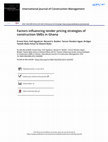
International Journal of Construction Management, 2019
Pricing strategy is a critical aspect of how a firm generates its revenue or profit and as such, ... more Pricing strategy is a critical aspect of how a firm generates its revenue or profit and as such, it remains an issue of prime importance to the construction industry. This article examines the relationship between factors that influence tender pricing and pricing strategies of SMEs construction firms in relation to competition-based, value-based and cost based pricing. In this article, Partial Least Square Structural Equation Modelling (PLS-SEM) is used to establish the relationship between factors that influence tender pricing and pricing strategies (constructs) derived from an analytical review of literature, coupled with a pilot study. The view of pricing experts working with SMEs construction firms was solicited using a structured questionnaire. Results showed that all nine constructs that were considered and that influence tender pricing had a high influence on the three pricing strategies identified (Cost-Based, Value-Based and Competition-Based). The findings of this study may be useful to SMEs construction firms in pricing as it will serve as a measure for achieving maximum profit. The study demonstrates how tender pricing factors can influence the choice of pricing strategies using PLS-SEM analysis based on the perspective of the SMEs.
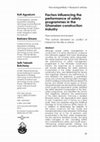
Acta Structilia, 2018
Although proper safety management in construction is of prime importance, evidence from literatur... more Although proper safety management in construction is of prime importance, evidence from literature suggests that many developing countries do not consider safety adequately. This article examines the factors that influence the performance of safety management programmes in the Ghanaian Construction Industry. The objectives set to achieve this aim include identifying the safety elements incorporated in the safety programmes of construction firms, and determining the factors that negatively influence the performance of such elements. For objectivity, a quantitative survey was conducted among safety managers of 60 D1 building construction firms located in the Kumasi and Greater Accra regions of Ghana. The questionnaire was structured into three parts, which sought the respondents' profile, identified the safety elements incorporated in the firms' safety programmes, and identified the factors that negatively influence the performance of the safety elements. Following a detailed literature review, the respondents were asked to rate 13 elements and 17 factors on a Likert scale. Data was analysed using the Statistical Package for Social Sciences (SPSS) Version 22. In addition to determining the reliability of the various constructs, the MSs, modes and standard deviations were obtained. The findings revealed that all of the 13 elements were incorporated in the firms' safety programmes. The key elements identified include 'providing safety managers on site'; 'providing written and comprehensive safety and health plans'; 'introducing project-specific training and regular safety meetings'; 'providing safety and health orientation training', and 'involving employees in safety and evaluation'. The findings further revealed that 16 of the 17 factors negatively influence the performance of the firms' safety programmes. The identified factors were, among others, 'insufficient communication of safety programmes'; 'lack of workers' self-protection and awareness'; 'contractors ignoring safety, due to the time pressures of the project schedule'; 'poor personal attitudes towards safety', and 'ineffective laws and lack of enforcement'. Findings from this study should be useful to construction practitioners seeking to improve the safety records of their firms.
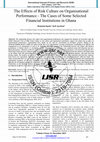
International Journal of Science and Research (IJSR), 2015
The relationship between risk culture and organisational performance has engaged the attention of... more The relationship between risk culture and organisational performance has engaged the attention of researchers after the Global Financial Crisis of 2008. Extant studies on risk culture and organisation performance suggest risk culture has an effect on organisational performance. Unfortunately these studies are few and are concentrated on developed countries. Relying on the Financial Stability Board's (FSB) risk culture model, due to its comprehensive coverage of all factors contributing to an effective risk management in an organisation as well as its simplicity, this study examined the relationship between risk culture and business performance in Ghana which is a developing country. Organisational performance was examined using both financial and nonfinancial measures. All factors of the two main variables of risk culture and organisational performance were measured using the Five-Point Likert Scale and were analysed using descriptive statistical measures. The data was obtained from the nineteen (19) banks listed on the Ghana Club 100 representing about 70% of the total market share of the Ghanaian Banking Industry, with both local and foreign origins. The analysis was based on 19 completed questionnaires, one (1) each from each respondent and interview responses from eleven (11) respondents. Individual respondents were purposively selected from risk related departments within the banks. The study revealed that there was no significant differences among the banks in terms of the risk culture determinants and organisational performance measures. In all cases, leadership action or inaction was identified as the attribute with the strongest potential for affecting the development an effective risk culture. Overall, there was a positive correlation between Risk Culture and Organisational Performance in the Banking Industry in Ghana. Finally, a generic Risk Culture Framework (RCF) was developed to facilitate the development of effective risk cultures across all organisations.

Uploads
Papers by Dr. Kofi Agyekum